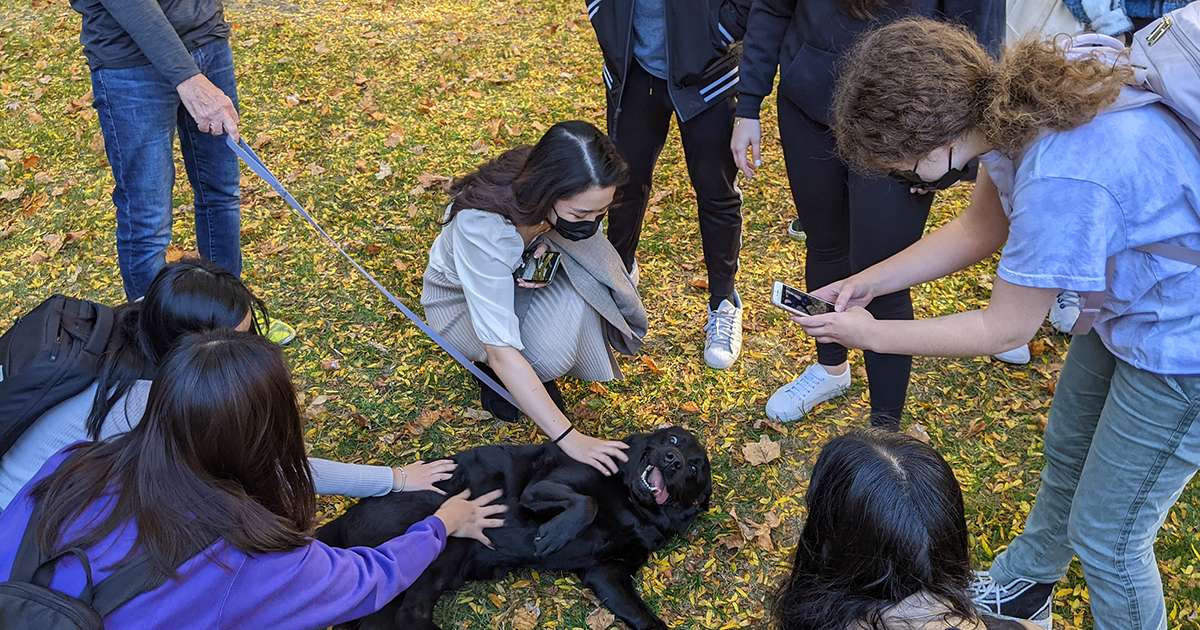Adopting a pet may seem like a selfless act, but there are plenty of selfish reasons to embrace pet ownership. Research has shown that owning a pet provides an amazing array of health benefits, says Jeremy Barron, M.D., medical director of the Beacham Center for Geriatric Medicine at Johns Hopkins.
Not ready for a full-time furry friend in your home? Offer to walk a neighbor’s dog, cat-sit for a friend, or donate time at a local animal shelter—even short interactions provide enough pet exposure to reap some of these rewards.
Reduce stress.
Research has shown that simply petting a dog lowers the stress hormone cortisol , while the social interaction between people and their dogs actually increases levels of the feel-good hormone oxytocin (the same hormone that bonds mothers to babies).
In fact, an astonishing 84 percent of post-traumatic stress disorder patients paired with a service dog reported a significant reduction in symptoms, and 40 percent were able to decrease their medications, reported a recent survey.
Lower blood pressure.
The cortisol-lowering and oxytocin-boosting benefits of petting also help keep your blood pressure at bay. “Petting and holding an animal allows you to appreciate the beauty of nature,” explains Barron. “It’s relaxing and transcendental.”
Increase physical activity.
How many people are willing to go outside at the crack of dawn and exercise in the rain or snow? Dog owners often have no choice—they have to walk their pet, thus providing them with an excuse-proof daily dose of exercise.
Boost heart health.
The American Heart Association released a research report endorsing dog ownership as a way of warding off cardiovascular disease .
Ease loneliness and depression.
A 2011 study found that pet owners had better self-esteem. Another study determined that pets provided greater social support than humans in mitigating depression. “Caring for a pet provides a sense of purpose to the owner,” says Barron. Plus, pets are a good social catalyst for meeting people who share your animal interests.
Help specific health concerns.
Beyond simple companionship, dogs have long been wonderful helpers to those without sight or with mobility issues. Dogs are even being used to help detect conditions from seizures to cancer.
How Therapy Dogs Help to Reduce Student Stress and Anxiety
As a result of the pandemic, natural disasters, and social anxiety, the importance of having a friend to lean on has never been so important. However, many fail to realize that friendships don’t always have to be between people. Thus, most students miss out on the benefits of having a therapy pet in their lives.
But how exactly do dogs aid in reducing anxiety and improving your overall health? If you want to know, keep on reading!
What are Therapy Dogs?
Certified therapy dogs volunteer alongside their owners in schools, clinics, and care facilities. From accompanying students to visiting a senior living facility, therapy dogs and their owners work collaboratively to better the lives of others.
Therapy dogs vs. Service Dogs: What’s the difference?
The terms “therapy animal” and “service animal” are often used interchangeably, although completely inaccurate. A service dog is a canine companion that has been trained to assist individuals with difficulties in their daily tasks. (animal-assisted therapy) Their common tasks include guiding the blind, notifying the deaf, pulling a wheelchair, and protecting patients suffering seizures.
On the other hand, therapy dogs don’t have the same level of training as service dogs. Nevertheless, they can help alleviate stress and mental pressure. On top of that, they have pleasant personalities and are easygoing.
While service dogs are not allowed to interact or be touched by anyone other than their owner, patients are encouraged to do so with therapy dogs.
What do Therapy Dogs do?
Due to their sensitivity to human emotion, dogs make excellent therapy animals. They have repeatedly demonstrated sympathy and empathy by nuzzling or moaning when they detect a human being is unhappy or in general emotional pain. Therapy dogs’ purpose is to bring comfort and company to any individual.
They are an added benefit in the rehabilitation and stress management processes due to their caring and compassionate nature. Therapy dogs frequently visit locations with vulnerable populations, such as nursing homes, hospitals, and college campuses, providing anxious patients and students comfort.
Unsurprising, therapy dogs are being introduced into business settings to help employees feel less stressed and more productive. Hence, their responsibilities range from actively participating in physical rehabilitation to building children’s and people’s confidence with mental or learning difficulties.
How Do Therapy Dogs Reduce Stress and Anxiety?
Most dog owners consider the connection with their dogs unconditional and dependable. Therapy dogs take that connection one step further. Those suffering from depression, stress, anxiety, and loneliness may find it difficult to open up, yet the presence of a therapy dog gives unlimited emotional support. Dogs won’t judge or condemn those they visit, and they provide smiles and a sense of security.
On top of that, petting a dog helps relieve stress and gives emotional support. The repetitive action produces oxytocin, a stress-relieving hormone that helps battle physical discomfort caused by melancholy, stress, or worry.
Benefits of Therapy Dogs in University
Therapy dogs have been shown to have several advantages in studies conducted in universities, including the following:
-
The rise in the number of students attending classes.
-
Learning outcomes such as increased reading and writing skills and greater motivation.
-
Improved connections with peers and instructors due to experiencing trust and unconditional love.
-
Improved communication skills.
Nonetheless, many universities opt out of therapy dog programs due to perceived threats. Concerns about hygiene and the suitability of a dog’s disposition for interacting with young adults are only two of the barriers.
Benefits of Therapy Dogs to Students
Therapy dogs are an excellent resource for calming and welcoming students. Sometimes the dog can feel who is in need and approach a particular student. The students will calm down, pat the dog, and resume their day. A small interaction can have a large impact on someone’s day.
This is a safe method for many students to be welcomed and relax into an otherwise anxious school day. Therapy dogs are often invited during finals week to allow students to break from their studies.
Other benefits include:
-
Reduced anxiety and depression.
-
Stress hormone reduction.
-
Improved social skills.
-
Normalized blood pressure and heart rate.
-
Gain confidence.
-
Improved motivation.
-
Positive attitude towards learning.
Making Your Dog a Therapy Dog
Therapy dogs are everyday pets. They do not need extensive training, although obedience training, whether in a class or at home, is very good for reinforcing the bond and communication between you and your pet. Therapy dogs must be well-mannered. No jumping or barking here! Most importantly, you and your dog need to have a bond that demonstrates not owner and pet but partners. For all the requirements to become certified with The Alliance of Therapy Dogs, go to www.therapydogs.com
Basic Requirements for Therapy Dog
-
Therapy dogs must be well-tempered.
-
Therapy dogs must be outgoing and friendly.
-
Therapy dogs must be adaptable to a variety of settings.
Value of Therapy Dogs
Simply having a therapy dog visit may help people forget their troubles, bodily or mental discomfort, and fears or maybe bring a smile. People’s mental and physical health has improved just by touching a dog. So when humans and animals interact, chemicals like serotonin, prolactin, and oxytocin are produced in the brain that plays a role in raising emotions.
Aside from helping people relax and enjoy the company of their animal therapy companion, it also gives comfort, decreases loneliness, stimulates the mind, and serves as a delightful diversion.
Final Verdict: Do You Need a Therapy Dog in Your Life?
Students may benefit from stress-relief programs, but adding therapy dogs may improve such initiatives even more. Even though therapy dogs can’t teach you the technicalities of learning, they can help you cope with your anxiety, improving your chances of academic achievement in the long run.
Indeed, many advantages of having therapy dogs in schools are undeniable, and ideally, this practice should be adopted even more.

At Tannenbaum Quad, Esha Pathi, a first-year student at the Wharton School, said spending even a little time with a therapy dog helps relieve stress.
“The last few weeks have been very stressful with a lot of assignments, and the weather is perfect today,” she said. “The opportunity to pet dogs is a big stress reliever. Just seeing a lot of people out here happy and not worrying about their obligations for a while is nice to see.”
The Wharton Undergraduate Division, in partnership with the Alliance of Therapy Dogs, provided the canines in November for a “Pawsitive Study Break,” part of the Division’s overall initiative to provide study breaks for students and give them a way to relieve stress during exam times.
Students participating in the program approached the dogs one-on-one or in small groups. The time students spent with a therapy dog varied from a few minutes to an hour.
“What I liked about this program is how it reminded me of the feeling I had at home with my own dog, and especially felt comforting when I started to miss my family and my own pet,” said Jeremy Calcarian, a first-year Wharton student in a demanding economics program. “It is a good stress reliever and good vibes. It’s calming and destresses you when you come out here with friends.”

Lee Kramer, director of student life at the Wharton Undergraduate Division, says the Division is focusing attention and programming on student wellness.
“Student well-being is vital and we want to make sure that we provide our students with wellness resources, programming, and initiatives throughout the year in order for them to flourish and thrive at Wharton and Penn,” he says. “The therapy dog event was a great opportunity for our students to unwind during a busy time of year and to connect with their peers, as well as with these amazing dogs.”
Such programs are becoming more common at universities as students cope with the challenges of student life and increasing workloads.
“Dogs offer a unique type of social support, as they can provide unconditional affection in a way that humans sometimes cannot,” says Lauren Powell, a postdoc at the School of Veterinary Medicine. “Studies show students generally feel less stressed after interacting with a therapy dog.”
Therapy dogs can also help students achieve a stronger sense of belonging and better deal with being homesick while lessening their anxiety. According to Powell, some of this can be explained by how human bodies respond to pleasant interactions with therapy animals.

“When we interact with dogs, we typically find our heart rate, blood pressure, and cortisol levels decrease, and our oxytocin levels often increase,” she says.
Lisa Podolsky, associate director of student life at Wharton and organizer of the event, says she was thrilled to be able to provide the therapy dogs to students.
“College can be a stressful time, and it’s hard to take a moment to breathe and relax
when there is always something that needs to get done,” she says. “The therapy dogs were intended to help students find balance and prioritize their wellness. This event gave students the chance to let go of their stress for a moment and experience joy.”
Not only did students revel in their time with the therapy dogs, but the dogs also seemed to enjoy spending time with the students. One of the handlers, Susan Kupper-Smith, who had her 10-year-old canine trained as a therapy dog, said participating in Penn’s study breaks also provides a great opportunity for her dog to gain experiences.
“It’s a nice event to share her love and therapy skills to help distract the students from the stress of work and school,” she said. “It’s also a learning opportunity, along with a chance for us to give back to the community.”



